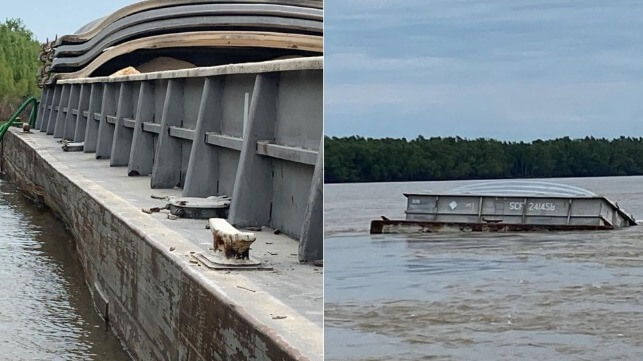Experienced Towboat Captain Cites "Complacency" for 2023 Bridge Strike

Most marine casualties are caused by human error, insurers' data shows, but rarely are they as cut and dry as the allision of the towboat Susan K with the Natchez-Vidalia Bridge last year. The captain told investigators that he simply became complacent after 200 trips on the same route, and wasn't paying attention in the moments leading up to the casualty.
On April 23, 2023, the Susan K was under way on the Mississippi with 25 barges in her tow, headed downbound for St. Rose, Louisiana. The captain had the watch as the towboat approached the Natchez-Vidalia Bridge, a large highway bridge with two 850-foot clear spans for barge traffic. Surface conditions and current were normal.
At about 2238 hours, the captain maneuvered to take the towboat through the recommended downbound channel, but - he later told investigators - he "wasn't paying attention." By the time he looked up to check the aids to navigation on the bridge and see how he was lined up, the Susan K was nearly 400 feet off track to the east.
The captain decided that it would not be possible to steer back onto track to make it safely through the designated span. To avoid hitting the bridge pier, he decided to maneuver to port and aim for the next span over to the east. He increased engine RPM to full ahead and attempted to make the turn, but was unable to fully avoid the pier. Though he averted a head-on collision, three barges in the middle of the starboard side of the tow made contact with the bridge at 2241, and the tow broke apart.
The master had 45 years of towboat experience, had completed 200 transits of the same bridge span in the same direction, passed a post-accident drug test, had no cell phone distractions, and had ample rest for the two previous nights. The root cause of the accident was simply complacency, he told NTSB. "You get complacent sometimes when you do something so many times and you're sloppy," he said.
"Repetition and familiarity reduce the required level of cognitive effort required to execute such tasks—even complex, skill-based tasks—increasing the susceptibility to attention lapses or distraction," cautioned NTSB. "Developing strategies that help maintain focus is a good practice. These strategies may include continuous scanning of instruments and surroundings outside the wheelhouse, strict adherence to procedures, eliminating distractions, changing position or moving."
